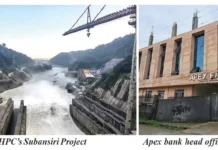[ Dr Jajati K Pattnaik ]
In the 21st century, a border is not a constraint; it is an element of cooperation.
Arunachal Pradesh, India’s tri-junction to the east, shares international borders with Myanmar (520 kms), China (1,080 kms) and Bhutan (217 kms). Conversely, the Look East Policy, which has been transformed into the Act East Policy under the present political dispensation led by Prime Minister Narendra Modi, also calls for a robust and result-oriented diplomacy to attain India’s national interests in its eastern neighbourhood.
Contextualized in Arunachal Pradesh, the policy has generated a lot of optimism among the academia, policymakers and other stakeholders in the state for a relook at the policy with a cross-border paradigm.
Nampong: Land corridor to ASEAN
Nampong, situated in Changlang district of Arunachal Pradesh, is a potential land bridge for India’s cross-border trade and economic collaboration with the Association of South East Asian Nations (ASEAN) countries.
Nampong was notified as a land customs station (LCS) in 1951. At present, Indian nationals are allowed to visit the Pangsau market (Myanmar side)
on the 10th, 20th and 30th of every month. Likewise, Myanmar nationals living within 16 kilometres of the border are permitted to visit Nampong every Friday to procure necessary items.
With the inception of the Act East Policy and the emergence of the free trade architecture in the region, the central government is co-opting all possible means to start formal trade by renovating the Nampong LCS. The much-awaited Nampong-ASEAN road corridor starts from Nampong (Arunachal Pradesh) and touches Shindbwiyang, Bhamo and Myitkyina in Kachin (Myanmar), linking the Ledo-Burma road junction through Wanding and Yunnanyi to the city of Kunming in Yunnan province (China).
The Myanmar government assigned contracts to the Yunnan Construction Engineering Group of China and the Yuzana Group of Myanmar in 2010 to reconstruct the 312 kilometre road from Myitkyina in Myanmar to Pangsau Pass on the India-Myanmar border. India has renovated its portion through two-lane highways, while China has renovated its own segment through six-lane highways. If the Myanmar segment is completed, the Nampong corridor can be connected to Muse, Lashio, Mandalay and Yangon (Myanmar) through Asian Highway (AH) 14, Ruili, Wanding and Kunming (China) through AH 3, and Bangkok (Thailand), Kuala Lumpur (Malaysia) and Singapore (Singapore) through AH 2, and further to Phnom Penh (Cambodia) and Ho Chi Minh City (Vietnam) of the greater Mekong sub-region through AH 1.
It is pertinent to mention here that the road distance calculated in this study between Nampong-Mandalay-Yangon (1428.2 kms), Nampong-Bangkok (2091.1 kms), Nampong-Kuala Lumpur (3436.7 kms), Nampong-Singapore (3795.2 kms), Nampong- Phnom Penh (2737.1 kms) and Nampong-Hanoi-Hochi Minh (3066.6 kms) is quite a feasible proposition in terms of cost benefit analysis, as compared to the trans-shipment of goods to Southeast/East Asia from the Northeast via the Kolkata port, passing through the Siliguri corridor.
The development of Nampong LCS would promote regional and sub-regional cooperation, and it would generate opportunities for Arunachal Pradesh to collaborate with the ASEAN, the Mekong-Ganga Cooperation (MGC), and the Bangladesh-China-India-Myanmar (BCIM) Forum on multiple fronts.
Kibithoo: Land corridor to China
Kibithoo is situated in Anjaw district of Arunachal Pradesh, at an altitude of 4,070 feet above sea level, as compared to Nathula Pass of Sikkim, which lies at an altitude of 14,400 feet above sea level. It enjoys geo-economic advantages to be developed as an all-weather road corridor to the Tibet Autonomous Region, and Sichuan and Yunnan of China.
If the Kibithoo corridor is taken up, it would provide shorter and faster access to the Indian industries to tap the southwestern and southeastern Chinese markets. It would counter Chinese penetration into the region while reinforcing India’s strategic significance along the McMahon Line.
It is pertinent to mention here that China has already built up several infrastructure projects along the international boundary, including opening up a new highway link to Medog – Tibet’s Nyingchi prefecture – which is nearer to India’s land border in Arunachal Pradesh. So India should lay thrust on the 1800 km kilometre frontier highway along the international boundary running parallel to China to connect the border areas. Moreover, the development of Kibithoo as an entrepot would give a chance to both India and China to switch their priorities from security to trade or economic collaborations based on sustainable engagement paradigms.
Notwithstanding its potentialities, the development of Kibithoo as an entrepot in the Sino-India border trade is still in a conceptual stage, although it has many backers at the civil society level. No such proactive step has yet been initiated by the political machineries, possibly due to the Chinese intransigence over the McMahon Line. Hence, the need of the hour is to break the Sino-India jinx over the border row and grab the opportunities through cross-border collaborations.
Proactive and sustained dialogues are to be pursued for economic engagement between India and China, going beyond the McMahon Line. What is required at this stage is a joint Sino-India effort to transform this geo-strategic zone into a geo-economic zone for a win-win situation for all the stakeholders.
Tawang: Land corridor to Bhutan
Tawang, situated in the western part of Arunachal Pradesh, is the land bridge to Bhutan. Given the strategic importance of the place, the Tawang-Trashigang (eastern Bhutan) road corridor should be developed to boost economic growth and development in the region. It would not only give quick access to Guwahati but also spread the tentacles for cross-border cooperation in the Himalayan frontier.
Beyond this, development of cross-border trade and cooperation in the Indo-Bhutan sector would pave the way for sub- regional cooperation based on shared ideas materializing through multitude of partnerships. It would also help in culminating a new sub-regional economic forum/growth triangle, consisting of western Arunachal Pradesh, Sikkim and North Bengal, eastern and southern Bhutan and eastern Nepal, subsequently strengthening the Bangladesh, Bhutan, India, Nepal (BBIN) sub-regional cooperation.
The way ahead
Arunachal Pradesh could be the bridgehead to East Asia. In this connection, it would be noteworthy to point out that special economic zones, as well as industrial corridors, should be developed in Arunachal Pradesh, and the potentialities of the state in the 5H (hydro, herbal, horticulture, handicraft and handloom) and the 2T (tradition and tourism) should be explored by tapping cross-border synergies.
Conversely, the threat perceptions, such as sneaking of drugs and small arms, illegal smuggling and dumping of Chinese goods, if any, should be identified and the challenges addressed by creating adequate space for trade to take off. Moreover, prior to the finalization of the eastward policy, it is highly necessary that Arunachal Pradesh should come up with specific manufacturing products and earn a ‘Make in Arunachal’ image to expand its global reach.
Thus, the need of the hour is to frame action-oriented policies along with a fresh vision document, ‘Vision 2040’, and then transform them into practice at the ground level for the benefit of all the stakeholders. Otherwise, it would remain purely a wishful thinking. (The writer is Associate Professor, Department of Political Science, Jomin Tayeng Government Model Degree College, Roing. He can be reached at Pattnaik.jajati66@gmail.com)




